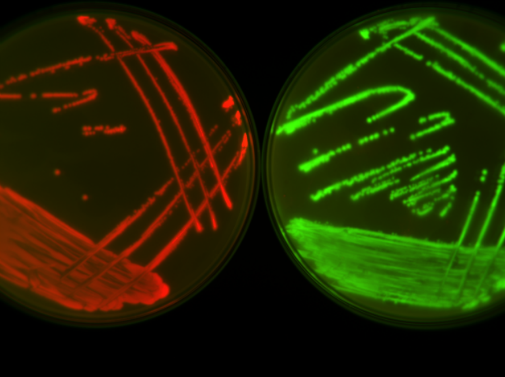Antibiotic resistance driven by intragenomic co-evolution

Scientists have discovered bacteria are able to "fine-tune" their resistance to antibiotics – raising the possibility of some superbugs being resistant to drugs which they have never even been in contact with.
Bacteria can become resistant to antibiotics in several ways. One really fast and effective way is by gaining extra DNA, called a plasmid, from other bacteria.
The plasmid provides bacteria with the genes needed to become resistant to specific antibiotics.
E.coli
Scientists know that in hospitals bacteria can spread resistance through these plasmids, but don't know much about how the plasmids and the bacteria form a relationship with each other.
Using a technique called experimental evolution, the scientists from the Universities of York and Sheffield, controlled the environment the E. coli were exposed to and allowed them to grow and evolve.
The bacteria were grown for 80 days (about 530 generations) exposing them continuously to an antibiotic.
During the 80 days the bacteria were exposed to the antibiotic, first they gained additional resistance mutations themselves, but this meant that the resistance provided by the plasmid was now somewhat redundant and could therefore be tuned down.
This produced a plasmid and host that were now dependent upon each other when exposed to this antibiotic.
First author Michael Bottery, from the University of York's Department of Biology, said: "Gaining resistance plasmids is just the start of the bacteria's journey to become resistant; the marriage between plasmid and bacteria is a complex one, involving both compromise and changes in behaviour.
"It is a relationship we need to unpick further in order to best preserve the use of the antibiotics we have for use in both critical and routine medical procedures.
"The experiment has shown that if you stop giving antibiotics, resistance won't go away. If you keep using the same antibiotics the bacteria will just get better and better by fine-tuning their resistance.
"And we have also shown if you give the same antibiotic over and over again it could also become resistant to completely different antibiotics which they have never seen before."
Co-dependent
Dr Jamie Wood, Senior Lecturer in Biological Modelling at York added: "The hosts have taken advantage of the plasmid resistance to evolve their own resistance and become co-dependent on each other.
"What we are really showing here is the relationship between the bacteria and these plasmids is a really complicated situation and we might be able to find better ways of managing it.
"Antibiotic resistance is a huge global threat - the UN has put it as equal threat as climate change.
"We need to gain this kind of basic scientific understanding of how bacteria become resistant, but also how they maintain resistance and how resistance changes over time."
More information: Michael J. Bottery et al. Adaptive modulation of antibiotic resistance through intragenomic coevolution, Nature Ecology & Evolution (2017). DOI: 10.1038/s41559-017-0242-3
Journal information: Nature Ecology & Evolution
Provided by University of York


















